How to Choose Durian Fruit? Mastering the Art!
Choosing the right durian fruit involves examining several key factors to ensure the best taste and texture experience.
Durian selection is crucial, as it varies widely in flavor and quality based on type, ripeness, and freshness.
To select a high-quality durian, be aware of the various varieties, inspect the husk for maturity, check for optimum ripeness, assess the aroma for freshness, examine the stem, feel the weight, and if possible, taste a sample.
When selecting durian:
Unlock the secrets to selecting the best durian for a truly indulgent tropical fruit experience.
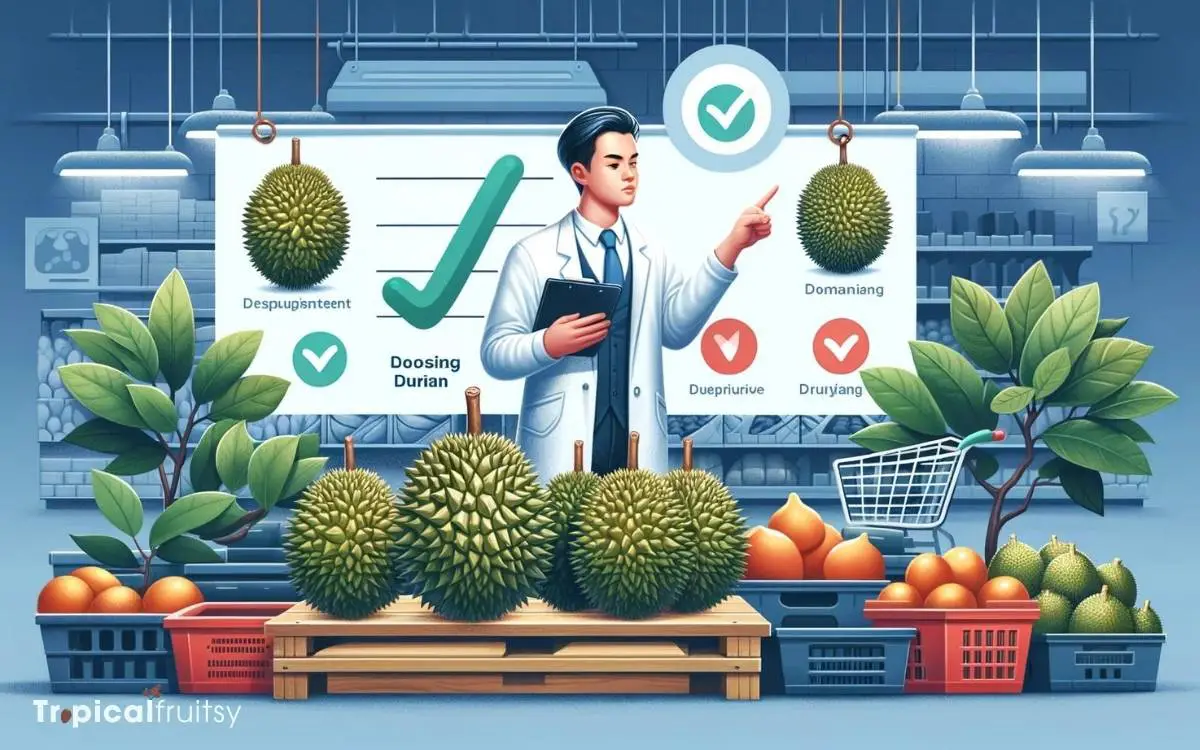
Key Takeaway
Durian Selection Guide: How to Choose the Best Durian
| Factor to Consider | Description | Why It Matters |
|---|---|---|
| Variety | Different durian types have unique tastes and textures. | Affects flavor and creaminess. |
| Husk Maturity | Look for a husk that’s starting to crack. | Indicates the fruit is ripe and ready to eat. |
| Ripeness | Gently press to feel slight give. | Ensures the flesh is soft and creamy. |
| Aroma | Should be strong and pungent, but not sour. | Sign of freshness and quality. |
| Stem Appearance | Preferably dry and brown. | Shows how long since it was harvested. |
| Weight | Should feel heavy for its size. | More flesh content, better value. |
| Tasting | Sample if possible. | Direct assessment of taste and texture. |
Know Your Varieties
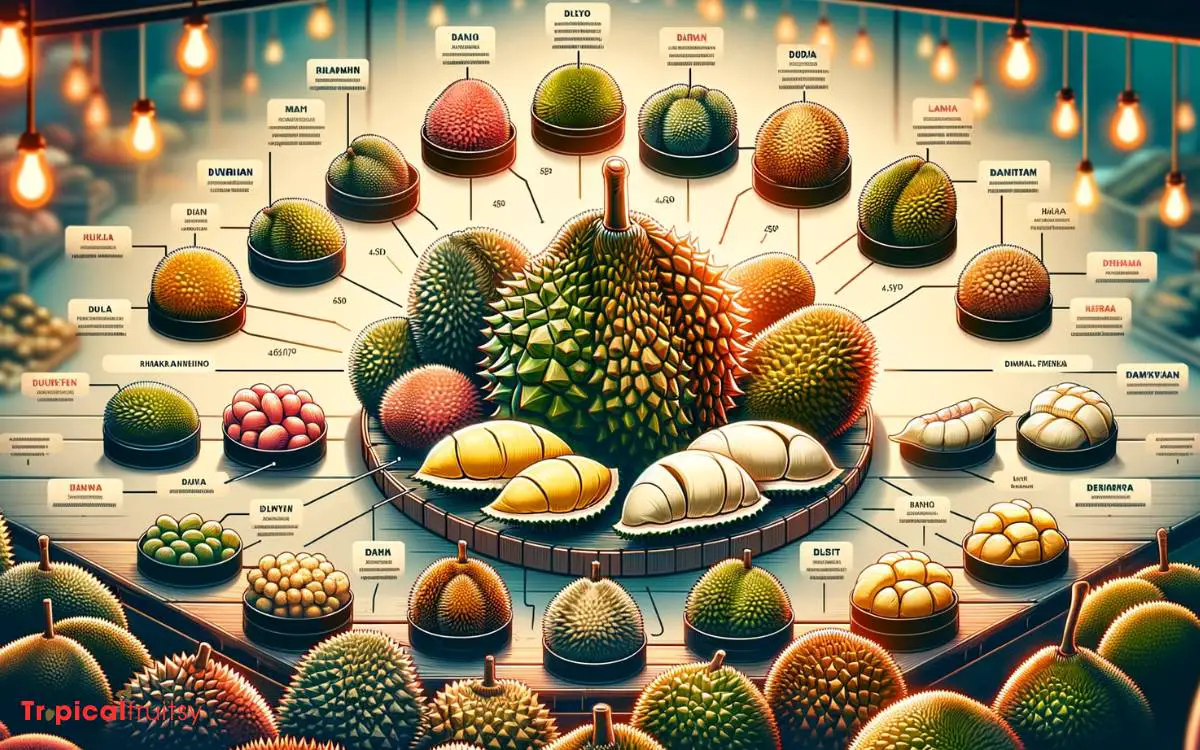
Understanding the distinct varieties of durian is crucial for selecting a fruit that caters to your taste preferences and texture desires.
Durians are not monolithic; their complex flavor profiles range from the intensely sweet to the subtly bitter, and textures vary from creamy to firm.
The ‘Musang King’ variety, for example, is renowned for its deep, custardy yellow flesh and sweet, lingering taste, often commanding a higher price.
In contrast, the ‘D24’ is slightly less sweet but noted for its creamy texture and almond-like hints. The ‘Red Prawn’, with its soft, reddish flesh, offers a complex palate of flavors, from sweet to winey.
Connoisseurs advise careful consideration of the fruit’s lineage, as each variety presents a unique sensory experience.
Assessing the Husk
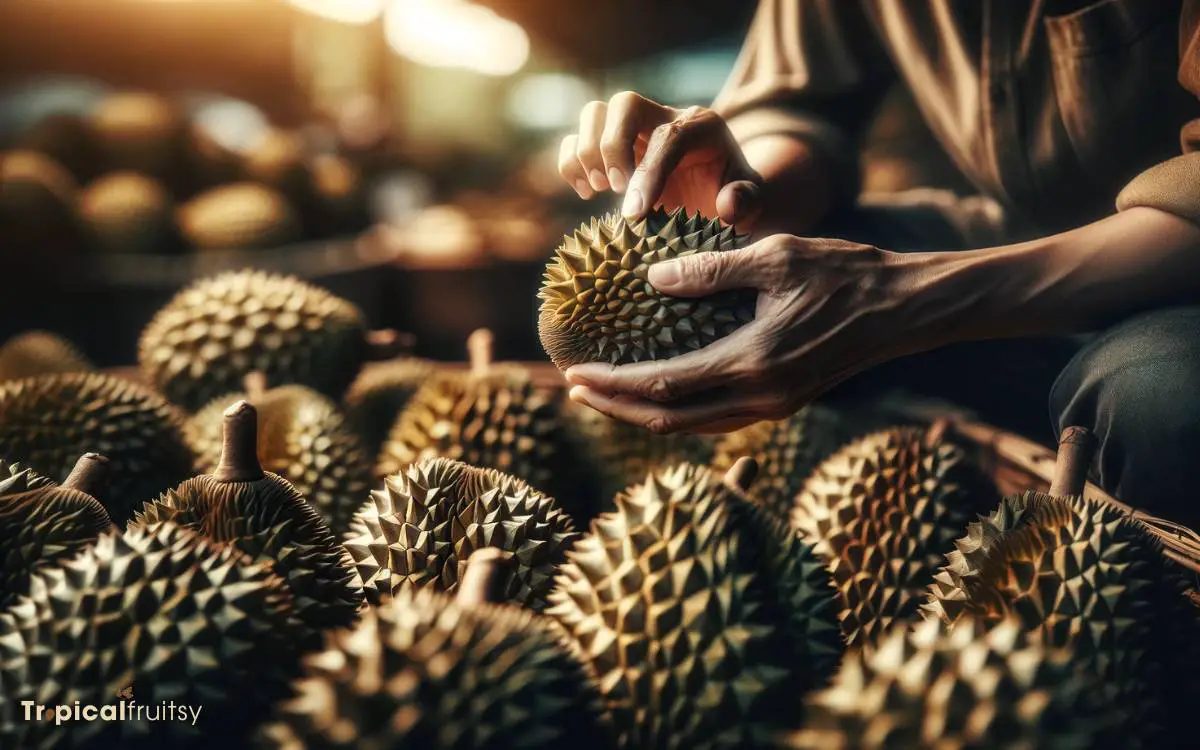
When selecting a durian fruit, a crucial step is to evaluate the condition of the husk, as it provides vital clues about the fruit’s ripeness and quality.
The color of the husk can range from a vibrant green to a brownish hue, each signaling a different stage of maturity, with uniformity in color often indicating consistent ripeness throughout the fruit.
Additionally, the husk’s firmness and texture should be examined; a durian that feels relatively firm to the touch and has spikes that are stout and not easily broken suggests freshness and a more favorable interior quality.
Husk Color Indicators
Several factors, including color variations in the husk, can provide valuable insights into the ripeness and quality of a durian fruit.
Novices and connoisseurs alike should observe the husk’s hue as a primary indicator:
- Greenish Husk: Suggests immaturity or under-ripeness.
- Brownish Tinge: Often indicates optimal ripeness.
- Uniformity: A consistent color implies even ripeness.
- Spots or Streaks: Could signify over-ripeness or rot in localized areas.
The subtleties in the husk’s coloration require meticulous examination. A well-ripened durian will typically exhibit a moderate brown hue, signaling readiness for consumption.
However, one must differentiate between natural browning and discoloration due to external damage or decay. Expertise in this area maximizes the chances of selecting a premium-quality fruit.
Firmness and Texture
The tactile quality of a durian’s husk, firm yet yielding slightly to gentle pressure, serves as a reliable gauge of its internal condition and ripeness.
A durian at its peak maturity should not exhibit a rock-hard exterior; rather, it should demonstrate a certain degree of suppleness that suggests the flesh within is creamy and ready for consumption.
Conversely, a husk that feels too soft may indicate overripeness or potential internal spoilage.
The texture of the husk also offers clues: a durian with a dry, slightly wrinkled husk typically signals ample ripening time, whereas a smooth, glossy surface might imply premature harvesting.
Experts will often palpate the entire fruit, seeking uniformity in firmness, which can be indicative of consistent quality throughout.
Check for Ripeness
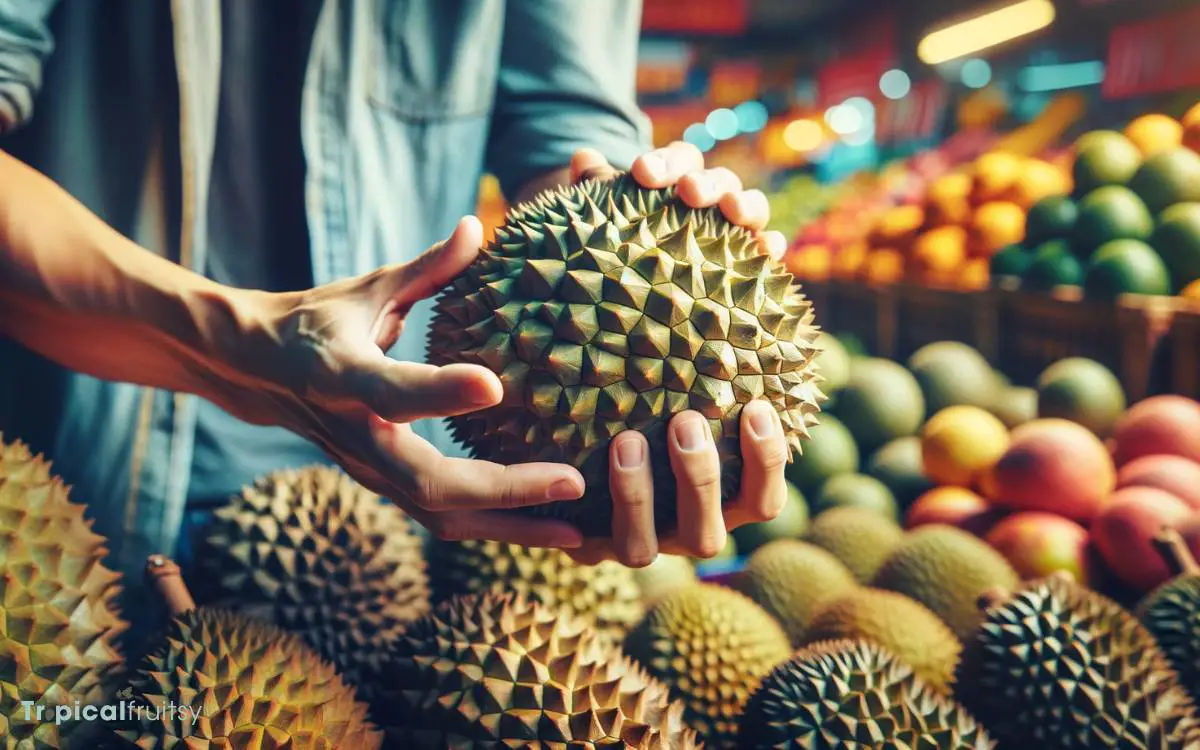
Inspecting the durian’s stem, a key indicator of ripeness, ensures that you select a fruit with optimal flavor and texture for consumption.
A fresh, stout stem that is neither too dry nor overly moist suggests that the durian was recently harvested and likely to be ripe.
Look for these characteristics:
- A dark brown and slightly withered stem indicates a ripe durian.
- A green stem suggests immaturity and potential lack of flavor.
Ripeness can also be assessed by the fruit’s aroma; a ripe durian emanates a strong distinctive smell that is easily detectable.
However, the intensity of the odor varies among different varieties. Gently shaking the fruit can also help; a subtle rattling sound of the seeds inside suggests the durian is ripe and ready to be enjoyed.
Smell the Aroma
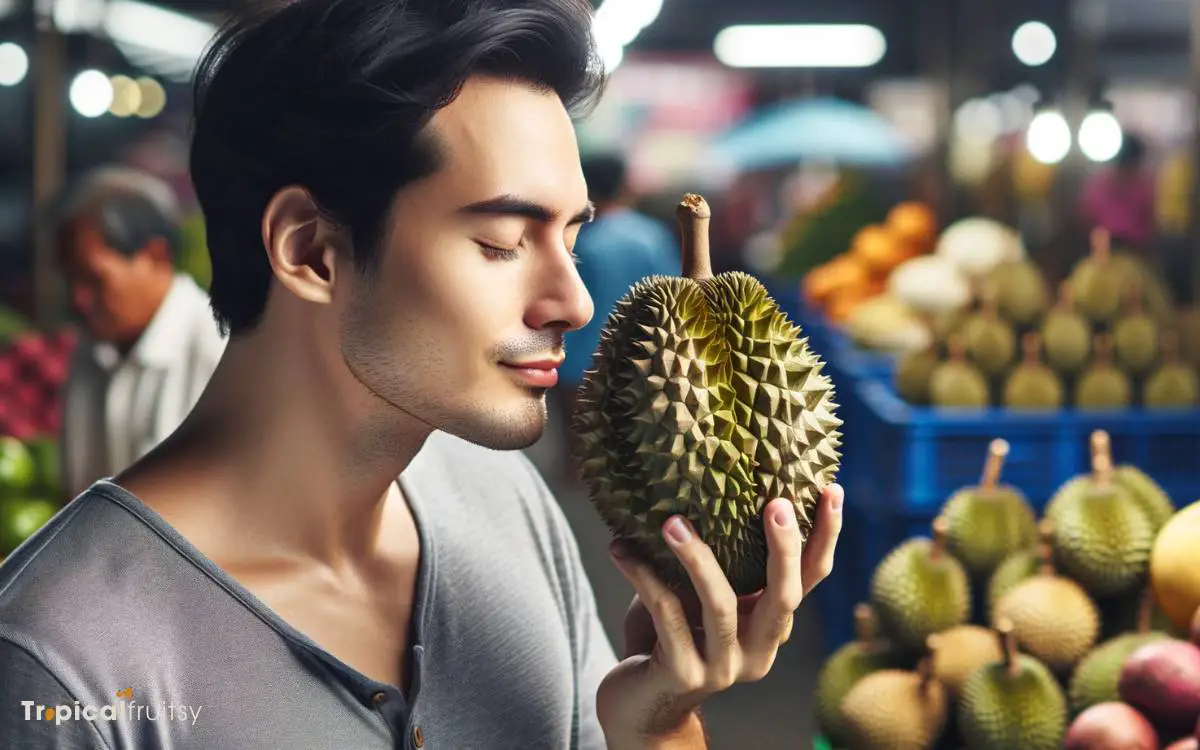
Upon approaching a durian, the intensity of its aroma, ranging from sweet to pungent, serves as a telling indicator of its ripeness and quality.
An expertly cultivated durian will emit a distinctive smell that suggests a complex blend of rich, custardy flavors with notes of almond and ripe tropical fruit.
This olfactory signature is the result of a combination of volatile sulfur compounds that develop as the fruit matures.
However, if the scent is overpoweringly sharp or unpleasant, it may indicate overripeness or fermentation, which can lead to a disagreeable taste. Conversely, an underripe durian may have a faint aroma, hinting at a lack of flavor development.
With the scent assessed, one’s attention should shift to examining the durian’s stem, another critical aspect in determining the fruit’s condition.
Examine the Stem
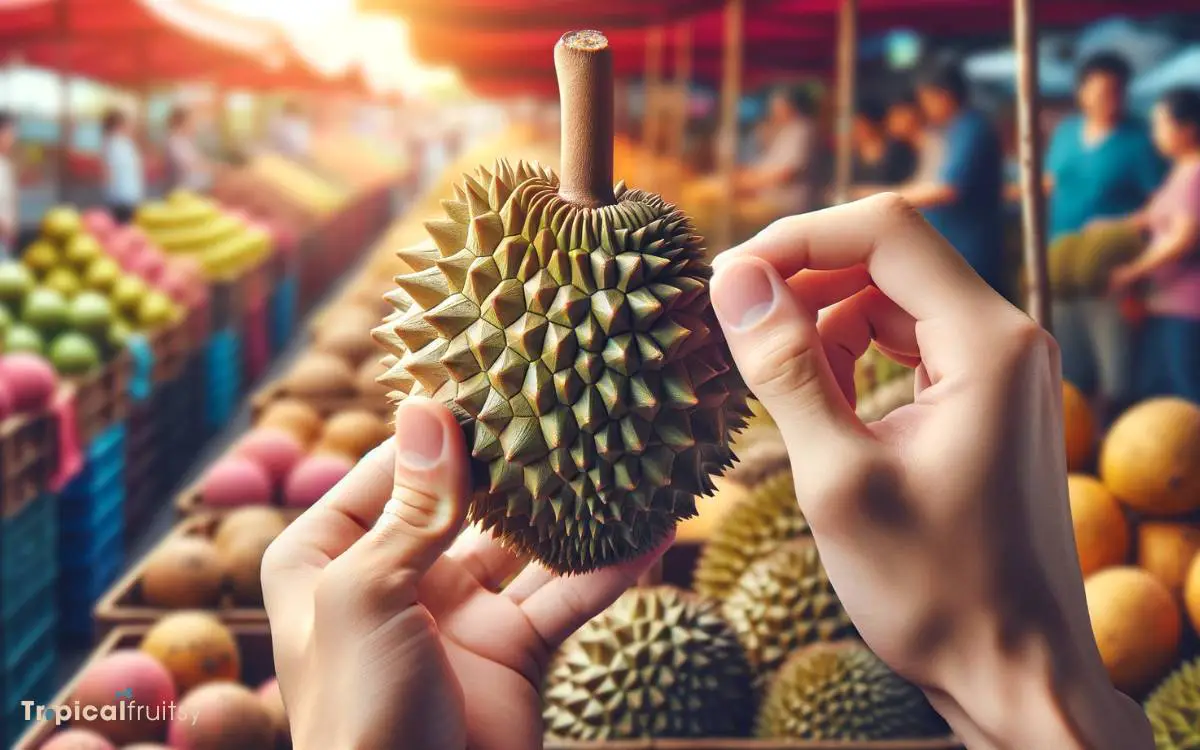
Moving on to the stem, a careful evaluation can reveal much about the freshness and ripeness of the durian.
When examining the stem, consider the following:
Appearance
- A dry, brittle stem indicates an older fruit that may have lost its optimal flavor.
- A stem that is brown, shriveled, and has cracks can also signify prolonged exposure to air, hinting at staleness.
Texture and Attachment
- The stem should be firmly attached to the fruit; a loose stem may suggest the fruit has been harvested for some time.
- A healthy stem is typically stout and slightly pliable, reflecting freshness.
These observations, combined with other sensory assessments, guide connoisseurs and novices alike in selecting a durian that promises a delightful eating experience.
Feel the Weight
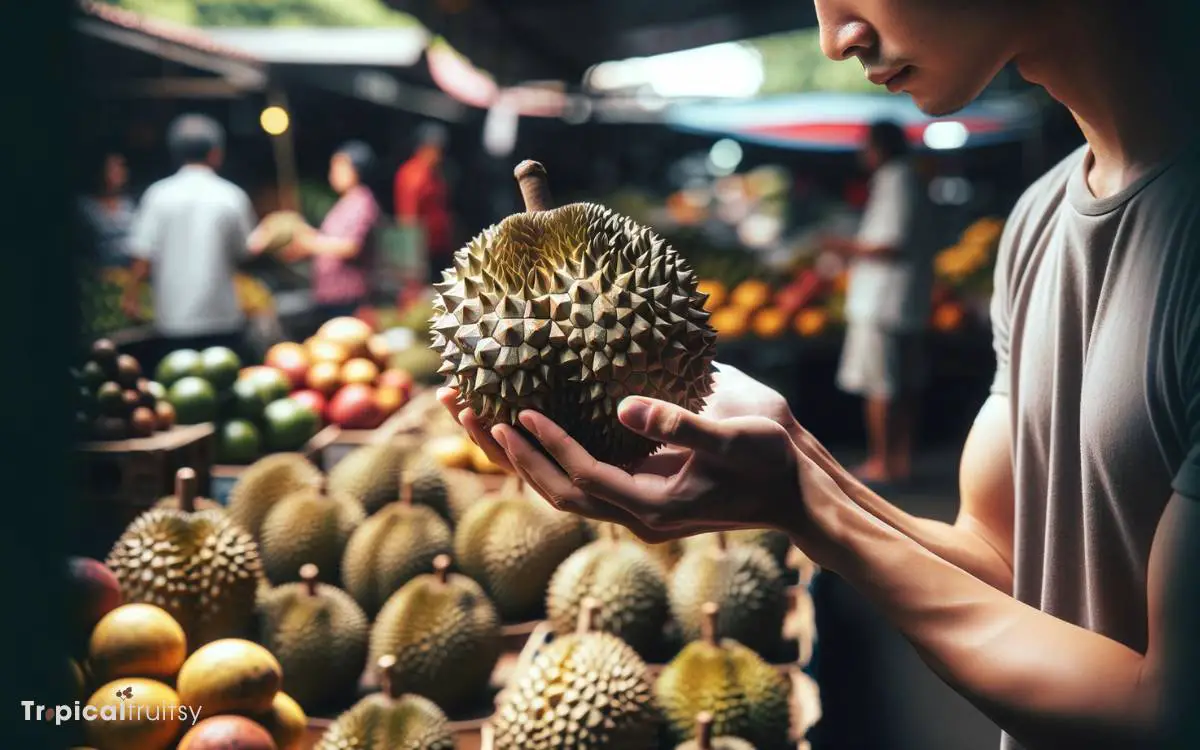
A durian’s weight is a significant indicator of its ripeness and overall fruit quality. When selecting durians, it is advisable to pick them up and assess their heft relative to their size, as a heavier fruit for its size suggests a desirable density of flesh.
It is also beneficial to compare the weight of durians of comparable dimensions to ascertain the best potential choice.
Heft Indicates Ripeness
The weight of a durian can be a reliable indicator of its ripeness. A fruit that feels heavy for its size often suggests a higher content of ripe, succulent flesh inside.
This tactile assessment should be combined with other sensory evaluations to ensure the selection of a quality durian.
Heft Test:
- Lift the durian gently: A durian that feels notably hefty indicates that it is packed with rich and creamy flesh.
- Compare with similar-sized fruits: Heavier durians among those of comparable size are typically riper.
Durian connoisseurs know that a fruit’s density is reflective of its inner quality. A durian that possesses a satisfying weight relative to its dimensions promises a delectable experience, with each segment potentially brimming with flavorful pulp.
Use this heft as a guide, but remember, it is one of several factors in choosing the perfect durian.
Compare Similar Sizes
When selecting a durian, it is essential to compare the weight of several fruits of the same size to gauge their ripeness accurately.
A durian that feels comparatively heavy for its size is often a sign that the fruit is ripe and contains an abundance of succulent flesh. Conversely, a lighter durian may indicate less flesh and potentially an under-ripe condition.
Expertise in choosing durian also suggests that a fruit with a denser weight distribution towards the stem is promising, as it often correlates with a richer taste and creamier texture.
With experience, one can discern subtle differences in weight that are not immediately apparent to the casual buyer, thus leading to a more satisfying purchase. Always handle the fruits gently to avoid bruising the delicate flesh inside.
Balance Weight, Size
Balancing the weight and size of a durian is a critical step in determining its ripeness and potential flavor profile.
A durian should feel heavy for its size, indicating a desirable flesh-to-shell ratio and a sign of ripeness. However, weight alone can be misleading without considering the size of the fruit.
Assessing Weight Relative to Size:
- Heavy for Size: Suggests ample, hydrated flesh; a lighter durian may be dry or overripe.
- Consistent Density: A uniform feel when turned indicates even ripeness.
Selecting a durian is a tactile experience. It should feel solid and succulent, not hollow or overly soft. Expertise in this area comes with practice, but a well-balanced durian often promises a rich and satisfying taste experience.
Tasting and Sampling

A durian’s flavor profile can be best ascertained through careful tasting and sampling, which is an essential step in selecting the ideal fruit.
Experienced durian connoisseurs know that nuances in taste can vary significantly from one fruit to another.
By sampling, one can detect the blend of sweetness and bitterness, the richness of flavor, and the creaminess of texture that are indicative of a high-quality durian. It is important to note that the taste can also be influenced by the variety and ripeness of the fruit.
| Aspect | Characteristic | Indicator of Quality |
|---|---|---|
| Sweetness | Rich, subtle | High sugar content |
| Bitterness | Mild to strong | Desired in some varieties |
| Texture | Creamy, smooth | Proper ripeness |
| Aftertaste | Lingering | Complexity of flavor |
Understanding these taste components will guide enthusiasts in distinguishing a premium durian from an average one.
How to Buy Good Durian
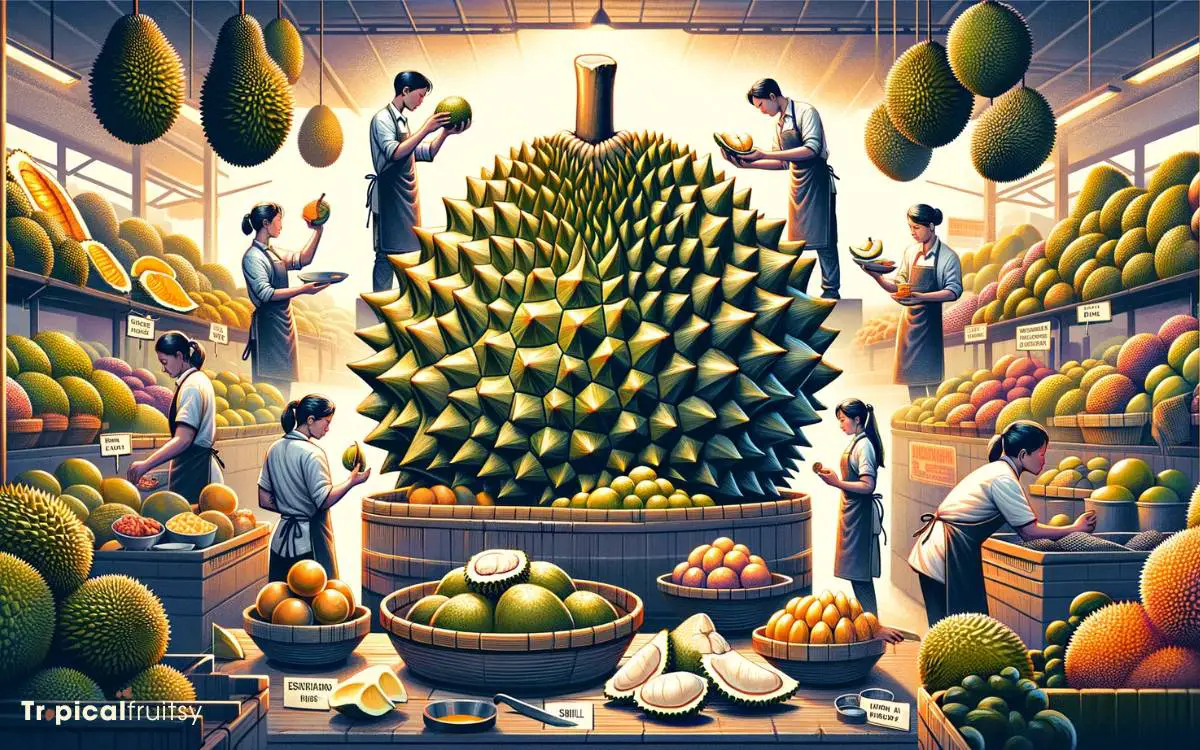
Buying good durian can be a bit challenging, as it’s important to select a fruit that is ripe, flavorful, and of high quality.
Here are some tips to help you choose a good durian:
- Smell the durian: The smell is one of the best indicators of a ripe and flavorful durian. A ripe durian should have a strong, sweet, and slightly pungent aroma. It should be inviting and appetizing. Avoid durians with a foul or unpleasant odor, as this could indicate overripe or low-quality fruit.
- Check the color: Examine the color of the durian’s spiky shell. The color can vary depending on the variety, but in general, a ripe durian will have a rich, golden-yellow to light brown color. Avoid durians with greenish or overly brown shells, as they may not be ripe.
- Look for cracks or splits: Inspect the durian for any cracks or splits in the shell. These can be signs of overripeness or damage. A durian with an intact, unblemished shell is preferable.
- Press the durian: Gently press on the shell with your fingers. A ripe durian should have a slight give, but it should not feel too soft or mushy. If it’s too soft, it may be overripe, and if it’s too hard, it may still need some time to ripen.
- Check the stem: Examine the stem or the area around it. If the stem is dry and looks brown or black, it’s a good sign that the durian is ripe. A green stem may indicate that the durian is underripe.
- Ask the vendor: If you’re unsure about selecting a durian, don’t hesitate to ask the vendor for assistance. Experienced vendors can often help you choose a good one and may even offer to open it for you to taste before purchasing.
- Know the variety: Familiarize yourself with the different durian varieties available in your area. Some varieties are known for their exceptional flavor and quality, so you can specifically look for those.
- Be patient: Durians ripen at different rates, and the flavor can vary from one fruit to another even within the same batch. If you have the opportunity, it’s best to develop a relationship with a trusted durian vendor who can provide you with high-quality fruit consistently.
Keep in mind that durian is a fruit with a strong and distinctive flavor that not everyone appreciates. If you’re new to durian, you may want to try it in a small quantity first to see if you like it before committing to a whole fruit.
Additionally, durians are typically sold by weight, so be prepared for the cost, as they can be relatively expensive compared to other fruits.
Conclusion
The selection of a durian fruit demands meticulous attention to detail. From understanding the diverse varieties to evaluating external indicators such as the husk, ripeness, aroma, and stem, each step is crucial.
Sensory analysis, combined with the heft of the fruit, offers additional insight. Expert sampling further refines the choice.
This methodical approach ensures that consumers can discern and select a durian that meets their expectations for flavor and texture.






